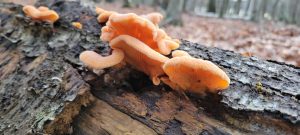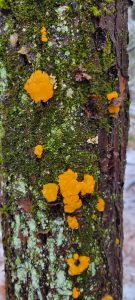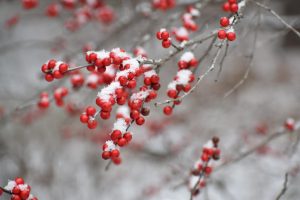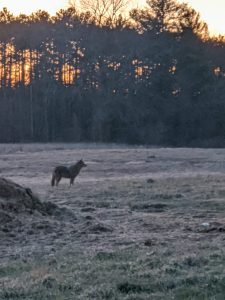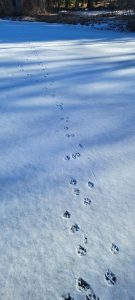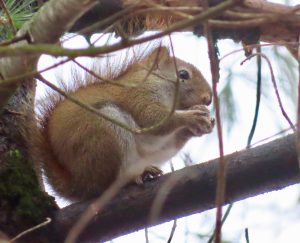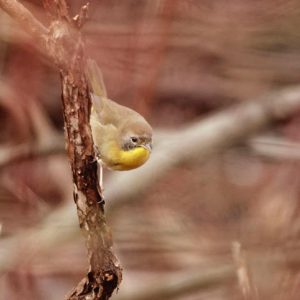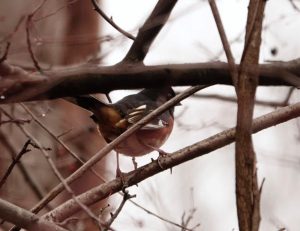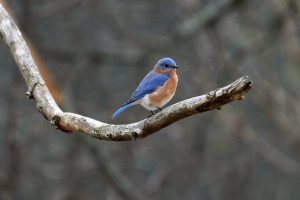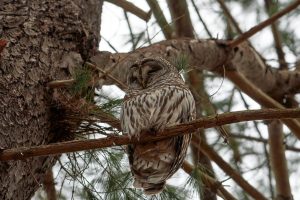Written by Gwyn Loud for the Lincoln Land Conservation Trust. She welcomes your sightings and questions at 781-259-8690 of gwynloud555@gmail.com
In view of the many uncertainties in our world, it is comforting to know that the Earth keeps spinning and making its way around the sun. Now that we have passed the winter solstice, the days are already noticeably lengthening, even though most of winter lies ahead. We have yet to have more than a couple inches of snowfall. Recent rain has been a boon to the water table, and it is a pleasure to see streams flowing fast and full.
Plants are resting at this time, but the buds on trees and shrubs are there, just waiting, and seeds and berries continue to provide food for wildlife, big and small. The colors of our snowless winter landscape are muted but beautiful, and fungi, for example, will reward the keen observer with spots of bright color. Late January is when I cut branches of forsythia to bring indoors, as the warmth of the house will force the flowers to bloom, a welcome sign of spring to come.
This is mating season for some of our common mammals. As Mary Holland writes about red foxes, “Red Foxes spend much of the year living a solitary life, but come January and February, during their courtship period, males join females. Nocturnal barking ensues and their pungent urine begins smelling strongly like skunk spray. Vixens come into heat for 1-6 days during this time and up to a week or two prior to this there is much interaction between a pair, when they often hunt and cover ground together. Once breeding takes place, they part ways. In about two months, when the young are born, the parents rejoin each other and raise their young together.”
Gray squirrels are in the midst of their first of two mating seasons (the second is May-July). The winter young are usually born in tree cavities, lined with grass leaves and strips of bark. Prior to mating, the squirrels do lots of chasing; apparently male squirrels can smell a female in estrus as far as half a mile away!
The peak of the breeding season for coyotes is mid-February. which may explain why I have heard coyotes howling frequently at night in recent weeks. They give birth in a den to 4–8 pups in April or May. The parents and pups will stay together through the summer, with the pups going off independently in the autumn.
Other mammals reported recently include bobcats in two different parts of town. One was seen near the condominiums on Todd Pond Rd. and the other in Browning Field South at dawn. Deer, fisher, a dead opossum, and raccoons have all been spotted. Raccoons are not true hibernators but spend the colder winter months in torpor, often in a tree cavity. They eat very little but live off the stored fat in their bodies, which may be more than 40% of their body weight. During mild spells, such as the ones we have experienced, they will emerge at night, perhaps to hunt for fish or crawfish in streams. Mating season for raccoons is from January to March.
On January 1, an unseasonably balmy day, volunteers tromped through fields and woods or watched birds at their feeders, participating in National Audubon’s Christmas Bird Count (CBC). Lincoln is on the eastern edge of the Concord Circle, which encloses all or part of eighteen towns. The CBC began in 1900 in a small way, growing each year, and in 1961 Peter Alden of Concord started the Concord Circle. Lincoln’s Norman Levey is the coordinator for the whole circle and he writes as follows about some of the results this year: “One record of note is our 94 species, breaking the 2000 and 2006 totals of 90. Count year 1962 tallied 48 species. On our first five CBCs tufted titmouse and Northern cardinal were counted with the fingers of one hand. A single red-bellied woodpecker was a shocker in 1968 and we never saw a yellow-bellied sapsucker until the turn of the 21st Century. Eastern meadowlark and ruffed grouse, formerly reliable on the count, have totally vanished and American kestrel, once a double digit annual is a rare Concord CBC visitor. Accounting for our more than fifty-three thousand birds was another massive American robin roost in Wash Brook, only a few hundred shy of the 2018 record. New high counts: Common Raven (35) and Eastern Bluebird (770). Low counts: Herring gull (6) continues to decline as a Concord count bird. Five thousand were tallied in 1996 before a commercial piggery and the last open dumps were closed. Cedar waxwings were the scarcest ever (49).” The results specifically for Lincoln can be seen by checking the designated link at the end of this column. Most people who were counting at their feeders reported lower than usual numbers, no doubt a factor of the mild weather. One nice surprise was a sighting of a common yellowthroat, a warbler usually long gone south by winter. An Eastern towhee was also found; a few of them often over-winter in our area.
The participants in our Lincoln count this year were Pam Boardman, Bob and Wini Blacklow, Cathie and Mathias Bitter, Larry and Kim Buell, Patti Cable, Carmela and John D’Elia, Marjorie Durand and Greg Stathis, Mark Elliott and Bernadette Quirk, Jason Forbes, Sarah Holden, Deborah Gerstein, Nancy Hammond, Rakesh Karmacharya, Norman Levey, Gwyn Loud, Sara Mattes, Mace Mayor, Ron McAdow and Betsy Stokey, Thomas Michel, Nancy Nicholson and Gray Shannon, Barbara Peskin, David Peterson, Anne Sobol, Nancy Soulette, Pam Sowizral, Peter Sperber, and Robin Wilkerson.
Weston feeder counters joining the Lincoln group this year were Bill and Pat Fitzsimmons and Doug and Kathy Langenberg.
Bird sightings in recent weeks which were not part of the CBC include a flock of horned larks which landed briefly in the Baker Bridge fields and a small flock of American pipits in the Food Project fields. In that same area a flock of over two hundred common grackles were seen. Are they very early spring arrivals or hangovers from last fall? A couple of belted kingfishers are still around; they will linger as long is there is enough open water for them to fish. Our local owls such as great-horned, barred, and screech have all been heard calling, and the great-horned, the earliest nesters, will lay eggs soon.
Those who like watching birds may want to participate in the annual Great Backyard Bird Count from Feb. 17-20. This is a global birding citizen science event and details can be found in the link below.
Looking skyward, four planets are visible in the evening sky, as explained in EarthSky: “Jupiter is easy to spot, brighter than all the stars. It’s in the southwest sky after sunset. It sets around 10:30 p.m. local time in mid-January and is gone after 9:30 p.m. at month’s end. Mars is high in the evening sky and is visible until a few hours before dawn. It’s very red now and brighter than most stars. Saturn is low in the southwestern sky after sunset. It’s golden in color and shines steadily, and the best time for observing is right after darkness falls. It sets by around 7 p.m. local time in mid-January and around 6 p.m. at the end of the month. Venus, the brightest planet and next planet inward from Earth in orbit around the sun, is climbing higher each night out of the sunset twilight. By the end of January, it sets about two hours after sunset.
===========================================================
To see the results of the Bird Count in Lincoln Jan. 1, 2023
To read about the history of the Christmas Bird Count in N. America, trends, etc.
https://www.audubon.org/conservation/science/christmas-bird-count/history-christmas-bird-count
To learn how to participate in the Great Backyard Bird Count Feb. 17-20, 2023
https://www.birdcount.org/about


